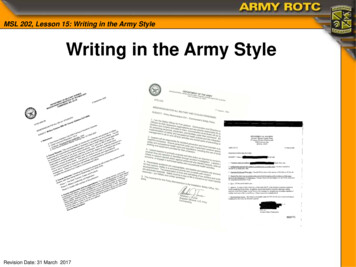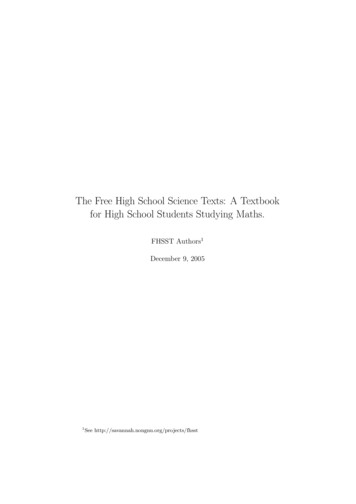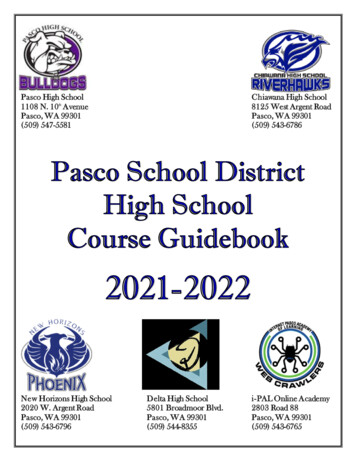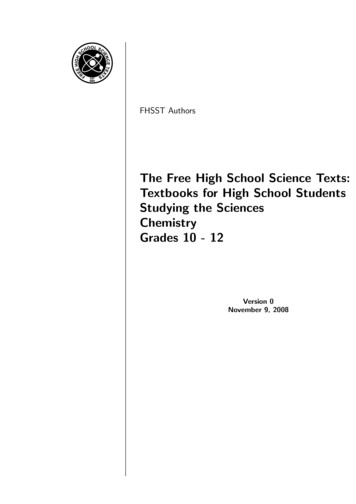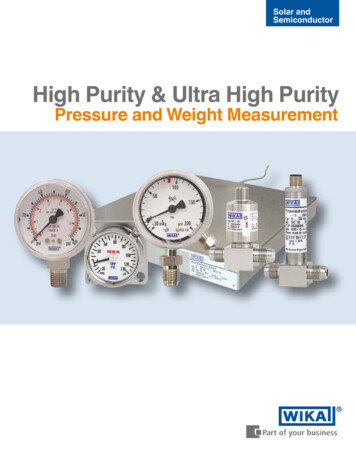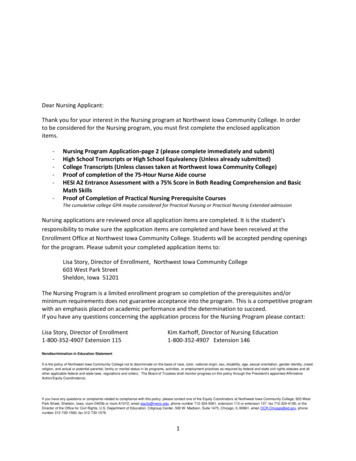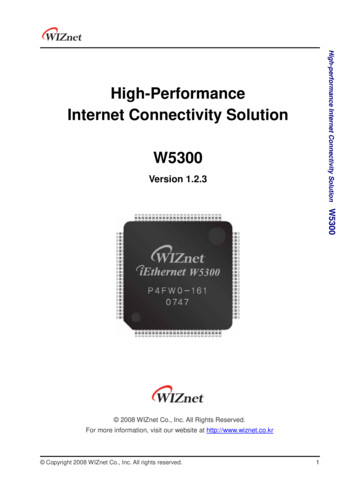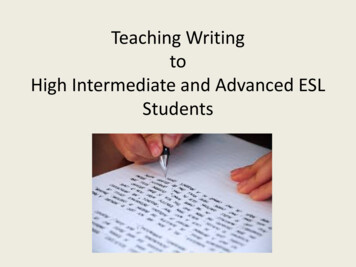
Transcription
Teaching WritingtoHigh Intermediate and Advanced ESLStudents
Today’s Agenda 1. Consider writing/composing andbeginner/advanced distinctions and activities 2. Examine Reading/Writing Link 3. Consider curriculum models 4. EAP: teaching models, rubrics 5. Essay Rating 6. Feedback 7. What Works: Writing, Hina and Sally
Writers make the best writing teachers
Differences between beginner/low intermediateand high intermediate/advanced ESL writersSentence/paragraph vs. composition, paperLittle control of grammar vs. basic controlLittle vs. significant use of metalanguageLittle vs. significant grasp of writingconventions Greater vs. less need for guided writing Little vs. greater ability for discussions/process Little vs. greater reading facility
Writing vs. ComposingParadigmsProductFormRhetorical ConventionAccuracyControl/ConformGrammar Extension Writing for its own sake
Activities for Writing vs. ComposingWriting:CopyingDicto compsChange, manipulate wordswithin sentencesGuided WritingSentence Combining(handout)ComposingFree writingBrainstormingElbow: writing as therapyClustering, word websJournals, logsBurke: heuristicsShaughnessy: writinglaboratories
Structural vs. Communicative:Finding the Middle Ground Shaughnessy: Errors & ExpectationsCannot ignore conventions, readers’expectations Be Level Appropriate: More control, guidanceat lower levels; more process in later levels Limits of free writing. Research: academicwriting seldom expressive, more controlledin topic, rhetorical choices
Finding the Middle Ground(continued) Learning styles necessitate blended approach:(independent: want linear, rule-governed;dependent: want cooperative, experiential) Don’t make your approach your religion“The good teacher is not so much one whoadheres strictly to a ‘method,’ but one who iscautiously eclectic” (D. Brown), “who recognizesthat teachers, rather than methods make adifference” (J. Reid).
Be eclectic but principled in youreclecticism (Stevens)Your class is not a variety show. Reading, Listening: Top Down and Bottom Up O.I.: Segmental and Suprasegmental Feedback Philosophy: Correct importanterrors but in a creative, supportive, nurturingclassroom environment Writing: Blend communicative, structuredapproaches
The Reading and Writing LinkAccording to the latest research, the mostreliable predictor of a child’s future academicand professional achievement is:The number of books in the house.
The Reading and Writing Link I. Both writers and readers construct andinterpret meaning from text (Johnson, Polman)Transactional link between writer/reader (Rosenblatt)Writer: constructs meaning; Reader: rediscovers meaning via schema II.Both are complex processes requiring manysubskills and are based on past experience(Harowitz)Subskills: pre-reading, inference, rhetorical organization, argumentation,persuasion, diction, organization, syntax. . .
The Reading and Writing Link III. Both are interactive, nonlinear, recursiveprocesses involving schemata in a critical role.The reader and writer each have drafts ofmeaning that can be “revised” based on new,emerging text (Straw)Jimmy Carter: The Hornet’s NestDavid McCollough: AdamsTolkien vs. Elijah Woods: The Lord of the Rings
The Reading and Writing Link IV. ESL students may have inaccurate “drafts”they apply to English text1. NNS use enculturated patterns of L1 topredict and comprehend (Carroll, Kaplan)2. Informing NNS of English discoursepatterns increases reading comprehensionRhetorical approaches still relevant, Reid;New work on genre study, Caplan
The Reading and Writing Link V. Direct correlation between readingproficiency and writing skill levels VI. Conversely, direct instruction in sentence,discourse, paragraphs improves reading(Belanger)
The Reading and Writing Link:Implications for TESL:A. Extensive reading for pleasure providesabundant comprehensible input (Krashen)vocabulary, style, structure, organization, rhetorical forms, toneB. Literature cultivates language awareness,cultural schema at language, content,rhetorical levels (Carrell, Carter, Long)Ex: Literature showcases American values:individualism, autonomy, inventiveness,action, freedom, personal expression,optimism. . .
The Reading and Writing Link:Implications for TESL: C. Essays from diverse fields cultivate critical thinking(Spack)1. Reading showcases critical thought2. Models rhetorical strategies forexpressing critical thoughtSwift: A Modest Proposal;MLK: I Have a Dream D. Include nonfiction and fiction: Mill, Carlysle, HO
Brainstorming Writing Activities
Curriculum Design Approaches A. Language Based Curriculum1. Writing used to consolidate oral/writtencommand of grammar2. Accuracy and correctness are paramount B. Pattern-Model-Base Curriculum1. Focus on function and situational writing,audience expectation2. Rhetorical modes and formats are key
Curriculum Design Approaches C. Process-Based Curriculum1. Emphasizes fluency, discovery, student needs2. Focus on negotiation of meaning3. Uses thematic units to provide engaging content tostimulate reading and writing D. Combined Curriculum1. Sees teaching of structure key to avoiding stigmatization2. Emphasizes teaching of rhetorical modes as critical to meetuniversity or professional expectations for prescribed forms3. Views writing as recursive process--involving manyinteractive phases of pre-writing, planning, composing,revising, editing Handout
Teaching EAP Writing A. Required for most ESL instructional settings:IEP, high school, middle school, Sixth grade ESL B. Expectations to be taught1. Student responsibility for their ownlearning2. Critical thinking--challenging status quo3. Rhetorical modes/forms4. Problem solving5. Participation in class, group tasks6. Original thinking7. Attributing non-original ideas/Plagiarism
Collins Writing Program Academic Honesty Compact
Informed Process Writing A. PreWriting1. Brainstorming2. Free Writing3. Webs/clustering/mapping4. Journaling5. Outlining6. CubingB. Drafting1. Group discussions2. Journaling3. Teacher Conferencing C. Final Drafting1. Peer feedback2. Instructor feedback3. Revision4. Editing
Journals--Key to Informed ProcessWriting"Mostconsistently effective tool for developing [written] fluency" (Kirby) A. Repository of pre-writing activities1. Brainstorming2. Free writing3. Log for ideas, notes4. Outline5. Early drafts B. Student/teacher dialogues, re: assignment/ideas1. Written or electronic dialogues2. Important that it's two waya. ask teacher questions about class materialb. raise problem areas in their writingc. express concerns, anxieties
Journals C. With other students--even around the world D. Metacognitive entries1. about the ways they think, write, & learn2. Reflect on decision making3. Grow to be more reflective writers E. Learning log application1. Students can summarize ideas of class2. Interpret and analyze material3. Explore ideas
Group response--making it work A. Most group work fails1. Failure to convince students of its value2. Failure to prepare students for group worka. Poor assumptions, re: group readinessb. Not considering L1 cultural interferencec. Lack of scaffolding and modelingd. Lack of planninge. Asking groups to do too much3. Failure to match studentsa. similar writing goalsb. good fit in temperamentsc. language strengths
Group response--making it work B. Creating writing community imperativefor successful groups1. Unified purpose2. Develop mentors:a. interview/introduce each otherb. journal about each otherc. group with other mentor pairs
Group response--making it work C. Building effective groups is process in itself1. Model with sample essay2. Begin with controlled activities3. Move to guided, never open4. Begin with very narrow, simple tasks5. Use groups as audience, not as grammar tutors6. Work to create a community of writers7. Give ground rules--comments acceptable/not8. Balance groups with teacher-centered work9. Best preceded by group collaborative projects
Feedback as Response to StudentWriting A. Group, Peer Response C. Formative teacher1. As reader, not raterresponses2. Responding to writer's specific ?s1. As audience3. Responding with reader’saddressing purpose,perspectivecohesion4. Group reviews not panacea B. Conferencing and tutoring (teacher)1. Outside of class, Socraticmethod2. Within class, more global3. Positive, encouraging2. As audienceresponding to content3. As consultant4. As describer
Feedback/Evaluation on Second orFinal Draft A. Errors--what research tells us (Scovel, Reid)1. Not deviant or random2. Systematic, developmental, rule-governed3. Result from L1 transfer, overgeneralization,and difficulty B. Goal of feedback is revision, not recopying
Feedback/Evaluation D. Research on Evaluation/Feedback1. Content faculty look for content/rhetorical2. ESL students, more than NES, want feedback3. Correction encouragement results4. Underlining errors significant improvement5. Content grammar feedback won'toverwhelm6. Feedback without follow up less effective
Feedback/Evaluation Rating/analysis sheets (see Collins handout,Reid p. 237) TWE --holistic ratings, criterion referenced
beginner/advanced distinctions and activities 2. Examine Reading/Writing Link 3. Consider curriculum models 4. EAP: teaching models, rubrics 5. Essay Rating 6. Feedback 7. What Works: Writing, Hina and Sally. Writers make the best writing teachers. Differences between beginner/low intermediate and high intermediate/advanced ESL writers Sentence/paragraph vs .
